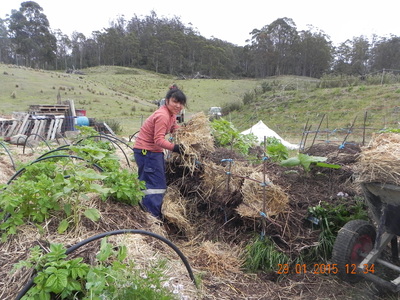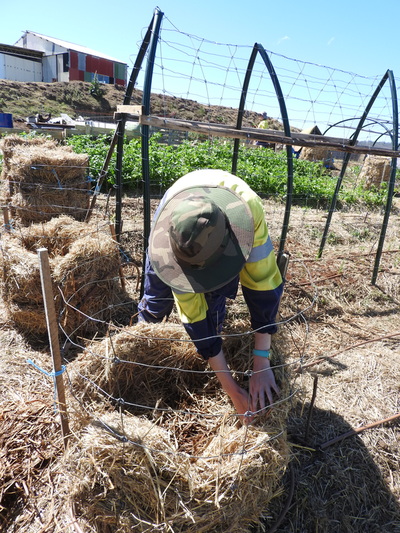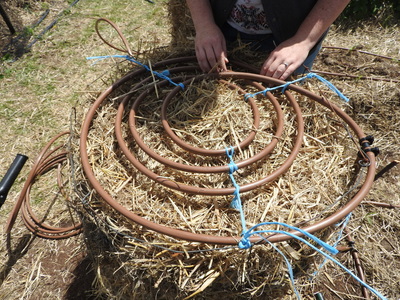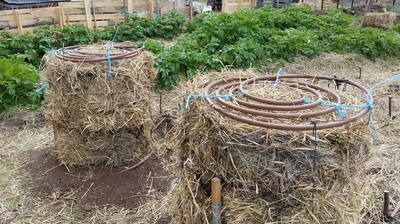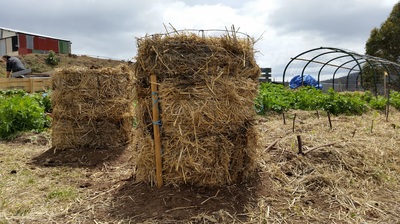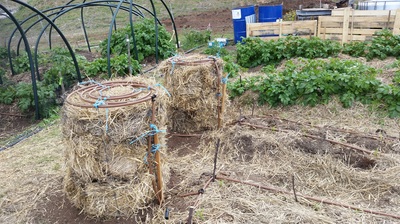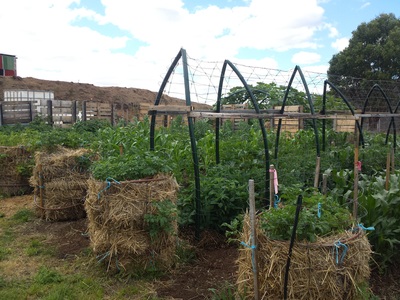Potato Towers - An experiment in vertical gardening.
This is the second year at growing potatoes. The first attempt was a bit of a flop as it was difficult to maintain a regular source of water and fertilizer. Yoshi, a volunteer last season, got creative and made cages from Dogwood and poly as her own idea and backfilled with straw biscuits and compost as the plants grew. We had tried to grow them in straw but the plants rotted and died.
This year I have planned the garden a bit better and started to grow the potatoes in mounded rows. Drip irrigation has been implemented at a rate of 2 liters per hour per dripper at 300mm spacing’s. I have about 7 varieties under cultivation at present including Pink Eye, Kennebec and a beautiful purple variety. The potato seed was cut to allow two shooting nodes to sprout and then covered with ash from the fireplace to seal the cut wound. This helps dry the wound and prevent rot when planted.
A smile came to my face when potatoes from last year’s beds have self-seeded. I thought it was a flop but there was some minimal success. The plants in that zone are huge due to the straw that has composted over them during the winter.
To try something quirky and creative, this year we are attempting to cultivate potatoes vertically. Were making potato towers. It’s a pretty simple process of a wire cage to retain straw and compost, layering potato seed in a ring inside the cage (approx. 6-8) at 300mm layers between straw and compost. Drip irrigation is added at the very top and will water all layers and peas and snow peas are planted at the base of each structure.
These potato towers are strategically placed at the end of beds to act as a wind breaks and each tower has 4 layers with 6-8 seeds in each which will grow out the sides of the straw and the cage. This equates to 24-32 plants per ½ square meter rather than 1 plant every 300mm which equates to one row of 8m or two rows of 4 m. If all goes well I could expect up to 30 kg per tower.
A very good space saver and a multifunctional as a windbreak.
This year I have planned the garden a bit better and started to grow the potatoes in mounded rows. Drip irrigation has been implemented at a rate of 2 liters per hour per dripper at 300mm spacing’s. I have about 7 varieties under cultivation at present including Pink Eye, Kennebec and a beautiful purple variety. The potato seed was cut to allow two shooting nodes to sprout and then covered with ash from the fireplace to seal the cut wound. This helps dry the wound and prevent rot when planted.
A smile came to my face when potatoes from last year’s beds have self-seeded. I thought it was a flop but there was some minimal success. The plants in that zone are huge due to the straw that has composted over them during the winter.
To try something quirky and creative, this year we are attempting to cultivate potatoes vertically. Were making potato towers. It’s a pretty simple process of a wire cage to retain straw and compost, layering potato seed in a ring inside the cage (approx. 6-8) at 300mm layers between straw and compost. Drip irrigation is added at the very top and will water all layers and peas and snow peas are planted at the base of each structure.
These potato towers are strategically placed at the end of beds to act as a wind breaks and each tower has 4 layers with 6-8 seeds in each which will grow out the sides of the straw and the cage. This equates to 24-32 plants per ½ square meter rather than 1 plant every 300mm which equates to one row of 8m or two rows of 4 m. If all goes well I could expect up to 30 kg per tower.
A very good space saver and a multifunctional as a windbreak.


